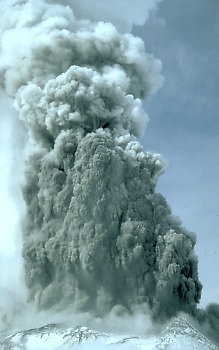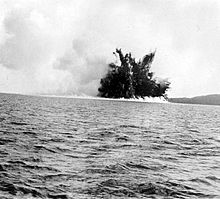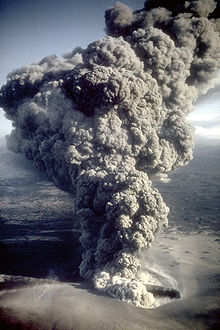Phreatomagmatic explosion



A phreatomagmatic explosion (of ancient Greek φρέαρ phréar , German , fountains' , genitive φρέατος phréatos ) is a volcanic explosion resulting from the direct contact of hot molten rock or hot pyroclastic density currents with external water results, for example, ground water, surface water, sea water or hydrothermal Water. The water can also come from a lake or glacier. The phreatomagmatic explosion is often followed by a phreatic explosionahead. It is therefore grouped together with this type of explosion (and other phenomena) under the umbrella term hydrovolcanism or hydromagmatism .
definition
The definitions are not uniform in the literature. The term phreatomagmatic explosion originally referred to a volcanic explosion when magma comes into contact with groundwater (= phreatic water), i.e. with fresh water. Contact with sea water or surface water was not originally included in this definition. However, this narrow understanding of the term could not be maintained. Today we speak neutrally of “external” water that comes into direct contact with magma and triggers water vapor explosions.
In the older literature, a phreatomagmatic explosion is often understood as the sequence from the phreatic explosion to the phreatomagmatic and possibly even to the magmatic explosion . Other authors refer to this type of volcanic explosion as a hydromagmatic explosion, or use the invasive hydrovolcanic explosion , which includes phreatic and phreatomagmatic explosions.
Emergence
A phreatomagmatic explosion can occur when external water, i.e. juvenile water not extracted together with magma or lava, comes into direct contact with magma , lava or hot pyroclastic density currents . This happens when:
- Groundwater (pore water) comes into direct contact with rising magma
- ascending magma penetrates into water-filled rock cavities
- Water from (crater) lakes comes into direct contact with magma through fractures
- Pyroclastic density currents flow into rivers, lakes or into the sea
- Lava flows out at sea depths above 200 m
- Sea water comes into contact with magma through fractures
- Surface water runs into the crater after heavy rainfall and seeps into loose material
The suddenly arising water vapor with 1000 to 3000 times the volume of the amount of water smashes the surrounding rock and bursts a crater into the rock bedrock. The ejected secondary rock is deposited as a wall around the crater. The pyroclasts are very severely fragmented through the direct contact of magma with external water ; however, these are not very blistered. Phreatomagmatic explosions can be followed by exclusively magmatic explosions. In this type of explosion, lava is also extracted relatively seldom . As a rule, the phreatomagmatic explosions end when the inflow of external water runs dry or the supply of magma comes to a standstill.
Creation of surges
Phreatomagmatic outbreaks can also generate high- energy surges (from English surges or base surges , also translated as pressure waves), a mixture of gases, water vapor, (old) rock particles and ash . The term “pressure wave” for this phenomenon is incorrect; therefore the technical term surge has become common. Surges, similar to pyroclastic currents, can propagate close to the ground at high speeds and with high destructive force. In relation to pyroclastic flows, they have a low particle density of between 0.1 and about 1%. If more than 75% of the particles are pyroclastic, these are also referred to as pyroclastic surges . In contrast to the hot and dry "glowing clouds", the surges of phreatomagmatic explosions are often "wet" and relatively cool (around 100 ° C) due to their high water vapor content.
Maars and their formation
Phreatomagmatic explosions are responsible for the formation of numerous maars . It can even be said that this type of eruption is the typical formation mechanism for maars. Rarely does the sequence continue to form purely magmatic outbreaks. Lava effusions are very rare. However, the phreatomagmatic outbreaks are often introduced by phreatic outbreaks. Some authors therefore refer to this sequence as phreatomagmatic bursts or do not differentiate between these two types of explosions.
See also
literature
- Meghan Morrissey, Bernd Zimanowski, Kenneth Wohletz and Ralf Buettner: Phreatomagmatic Fragmentation. In: Haraldur Sigurdsson (Ed.): Encyclopedia of Volcanoes. Pp. 431-445, Academic Press, San Diego et al. Places, 2000, ISBN 0-12-643140-X .
- Hans Pichler and Thomas Pichler: volcanic areas of the earth. Spectrum Academic Publishing House, Heidelberg 2007, ISBN 978-3-8274-1475-5 .
- Gerd Simper: Understanding and experiencing volcanism. Feuerland Verlag, Stuttgart 2005, ISBN 3-00-015117-6 .
Web links
Individual evidence
- ^ A b Elisabeth A. Parfitt, Lionel Wilson: Fundamentals of Physical Volcanology. Blackwell Publishing, Victoria (Australia) 2008, ISBN 978-0-63205443-5 .
- ^ A b Hans-Ulrich Schmincke: Volcanism. Springer Verlag, 2004, ISBN 3-540-43650-2 .

